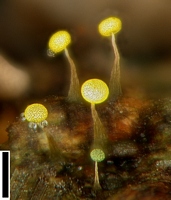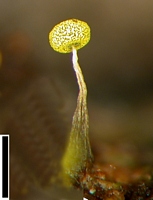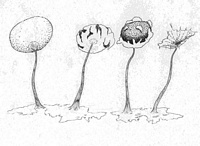|
 Physarum viride Physarum viride
SynonymsPhysarum viride var. aurantium
Sphaerocarpus viridis
BiostatusPresent in region - Indigenous. Non endemic
Images (click to enlarge)
Caption: scale=0.5mm
Owner: J.A. Cooper | 
Caption: scale=0.5mm
Owner: J.A. Cooper | 
Caption: Four sporangia of Physarum viride. The sporangium on the left is about 1.3 mm tall.
Owner: S.L. Stephenson |
Article: Stephenson, S.L. (2003). Myxomycetes of New Zealand. Fungi of New Zealand. Ngā Harore o Aotearoa 3: xiv + 238 p. Hong Kong: Fungal Diversity Press.
Description: Fruiting body a stalked sporangium, gregarious, 1.0–1.5 mm tall. Sporotheca subglobose or lens-shaped, usually nodding, pale to deep yellow, greenish or greyish to golden or reddish orange, 0.3–0.7 mm in diameter. Stalk noncalcareous, slender, tapering, longitudinally wrinkled, and usually dark in colour, becoming less so toward the apex. Hypothallus inconspicuous. Peridium consisting of a single layer encrusted with lime, dehiscence irregular above and more or less floriform below. Capillitium consisting of a network of colourless slender threads with interspersed small, white lime nodes. Spores black in mass, pale liliaceous brown by transmitted light, minutely spiny or nearly smooth, 8–10 µm in diameter. Plasmodium yellow or greenish yellow.
Habitat: Decaying wood and bark, old sporocarps of fungi, and less commonly leaves and herbaceous debris.
Distribution: Considered as cosmopolitan by Martin & Alexopoulos (1969). First reported from New Zealand by Lister & Lister (1905), based on a specimen collected on Stewart Island. Also known from Northland, Auckland, Coromandel, Bay of Plenty (Cheesman & Lister 1915), Taupo, Gisborne, Buller, Westland, South Canterbury (Rawson 1937), Dunedin, Southland, Auckland Islands, and Campbell Island.
Notes: This is the most common species of Physarum in the forests of New Zealand. The bright yellow sporangia usually stand out in marked contrast to the substrate upon which they occur, making this an easy species to detect.
|